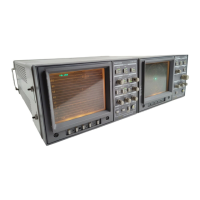1730–Series Theory of Operation
4–24
Front Panel
Diagram 7
The front-panel indicators are driven from Microcontroller light driver register
and LED drivers from Diagram 5. The front-panel switches are momentary
closure (with some hold for additional function capabilities) that are monitored
by the Microprocessor, which is also on the Microcontroller (Diagram 5). In
addition a series of front-panel controls provide variable dc operating levels as a
means of compensating for variable operating requirements and conditions.
The front-panel LED indicators are arranged in six columns returned to a current
source by four returns, designated as rows, in order to provide the Microproces-
sor with a set of column/row matrix addresses. An LED indicator lights when
there is a complete circuit from the Light Driver (Diagram 5) through the LED
and back to the Light Driver.
Switches complete a simple matrix that is read by Port 1 of the Microprocessor.
A completed circuit through the processor (switch closure) dictates an output
through the Data I/O that changes one or more operating conditions. Some of
the switches are read in two different ways by the Microprocessor. When
touched and released they cause the Microprocessor to toggle to the next item on
that switch’s menu. When held in, the Microprocessor selects a specific
operation. Hold for function switching options are outlined in blue on the front
panel.
A set of variable controls consisting of the Horizontal Position, Vertical Position,
Vertical Calibration, Scale, and Focus controls select a dc voltage level between
+11.8 V and –11.8 V.
The INTENSity control operates in conjunction with the Z-Axis Control circuit
on Diagram 6. DC levels for Intens 1, Intens 2, and Intens 3 depend on the
operating mode selected, which dictates the level on each of the leads.
Indicators and Switches
Controls

